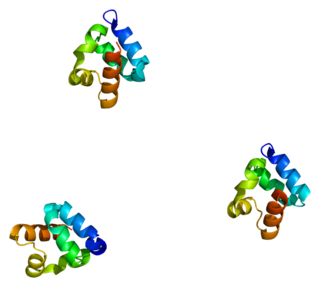
SLITRK1 is a human gene that codes for a transmembrane and signalling protein that is part of the SLITRK gene family, which is responsible for synapse regulation and presynaptic differentiation in the brain. Expression of the gene has been linked to early formation of excitatory synapses through binding with receptor tyrosine phosphatase PTP (LAR-RPTP). Various studies over the years have linked mutations in the gene to conditions on the OCD spectrum, Tourette syndrome and trichotillomania, however the mutations in the genome itself vary greatly between individuals, with most mutations observed being hard to find in repeat studies.

NACHT, LRR and PYD domains-containing protein 3 (NALP3), also known as cryopyrin, is a protein that in humans is encoded by the NLRP3 gene located on the long arm of chromosome 1.

LRRTM1 is a brain-expressed imprinted gene that encodes a leucine-rich repeat transmembrane protein that interacts with neurexins and neuroligins to modulate synaptic cell adhesion in neurons. As the name implies, its protein product is a transmembrane protein that contains many leucine rich repeats. It is expressed during the development of specific forebrain structures and shows a variable pattern of maternal downregulation.

Leucine-rich repeat-containing G-protein coupled receptor 6 is a protein that in humans is encoded by the LGR6 gene. Along with the other G-protein coupled receptors LGR4 and LGR5, LGR6 is a Wnt signaling pathway mediator. LGR6 also acts as an epithelial stem cell marker in squamous cell carcinoma in mice in vivo.

NLR family CARD domain-containing protein 4 is a protein that in humans is encoded by the NLRC4 gene.

Lysine-specific demethylase 2A (KDM2A) also known as F-box and leucine-rich repeat protein 11 (FBXL11) is an enzyme that in humans is encoded by the KDM2A gene. KDM2A is a member of the superfamily of alpha-ketoglutarate-dependent hydroxylases, which are non-haem iron-containing proteins.

Leucine-rich repeat flightless-interacting protein 1 is a protein that in humans is encoded by the LRRFIP1 gene.

Leucine-rich repeats and immunoglobulin-like domains protein 1 is a protein that in humans is encoded by the LRIG1 gene. It encodes a transmembrane protein that has been shown to interact with receptor tyrosine kinases of the EGFR-family , MET and RET.

Leukocyte immunoglobulin-like receptor subfamily B member 3 is a protein that in humans is encoded by the LILRB3 gene.

Leucine-rich repeat-containing protein 41 is a protein that in humans is encoded by the LRRC41 gene.

SH3 and multiple ankyrin repeat domains 3 (Shank3), also known as proline-rich synapse-associated protein 2 (ProSAP2), is a protein that in humans is encoded by the SHANK3 gene on chromosome 22. Additional isoforms have been described for this gene but they have not yet been experimentally verified.

Leucine-rich repeat-containing protein 39 is a protein that in humans is encoded by the LRRC39 gene.

Fibronectin leucine-rich repeat transmembrane protein FLRT2 is a protein that in humans is encoded by the FLRT2 gene.

Leucine-rich repeat-containing protein 17 is a protein that in humans is encoded by the LRRC17 gene.

Transmembrane channel-like 8 is a protein which in humans is encoded by the TMC8 gene.

NLRC3, short for NOD-like receptor family CARD domain containing 3, is an intracellular protein that plays a role in the immune system. It was previously known as nucleotide-binding oligomerization domain, leucine rich repeat and CARD domain containing 3 (NOD3) and CLR16.2. NLRC3 inhibits the activity of T cells.

Leucine rich repeat containing 16A is a protein that in humans is encoded by the LRRC16A gene. The gene is also known as LRRC16, CARMIL, CARMIL1 or CARMIL1a.

F-box and leucine-rich repeat protein 4 is a protein that in humans is encoded by the FBXL4 gene.

Leucine rich transmembrane and O-methyltransferase domain containing is a protein that in humans is encoded by the LRTOMT gene.

Leucine rich repeat containing 24 is a protein that, in humans, is encoded by the LRRC24 gene. The protein is represented by the official symbol LRRC24, and is alternatively known as LRRC14OS. The function of LRRC24 is currently unknown. It is a member of the leucine-rich repeat (LRR) superfamily of proteins.




















